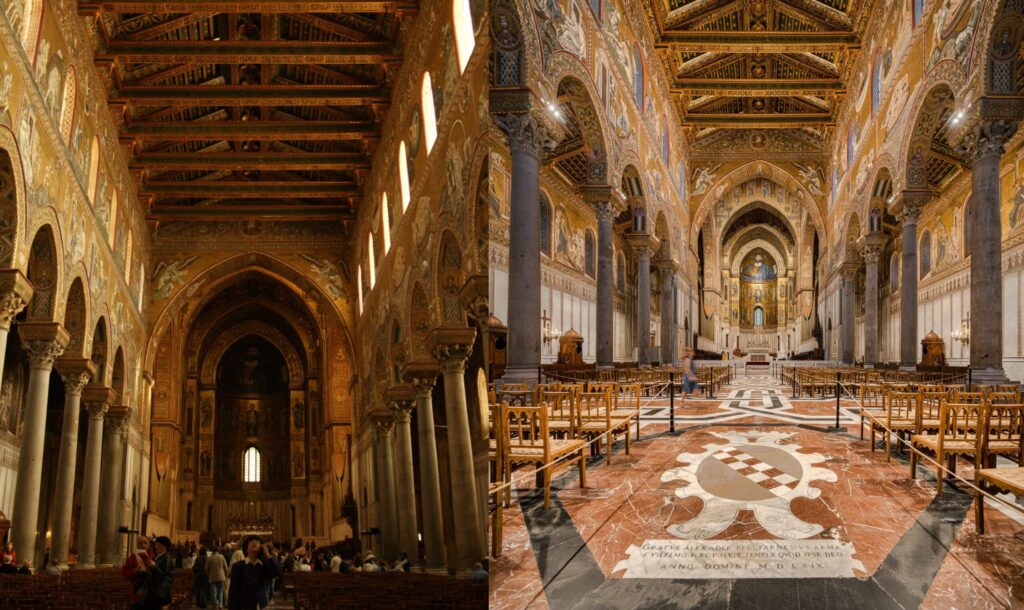A medieval Italian masterpiece, the Cathedral of Monreale, has undergone a dramatic transformation, unveiling a remarkable new look thanks to an advanced lighting renovation. This UNESCO World Heritage Site, renowned for its intricate gold mosaics and biblical artistry, now shines with renewed brilliance, offering visitors a fresh perspective on its architectural and artistic grandeur.
This marks the first major restoration of the Cathedral of Monreale since 1978, an effort that involved meticulously cleaning its iconic mosaics and installing a state-of-the-art lighting system. Dating back to the 12th century, this Norman cathedral, situated just outside Palermo in Sicily, stands as one of the most remarkable examples of medieval architecture in Italy, blending Byzantine, Arab, and Norman influences into a singularly breathtaking design.
The year-long project was led by Zumtobel, an Austrian lighting specialist renowned for its expertise in illuminating cultural and historical landmarks. Tasked with modernising the cathedral’s outdated lighting system, Zumtobel developed a customised LED solution designed to enhance the brilliance of the mosaics while preserving the sacred and historical atmosphere of the space. Their innovative system ensures both energy efficiency and flexibility, adapting seamlessly to the diverse uses of the cathedral, from religious ceremonies to art history tours.
“There was a very old system,” explains Matteo Cundari, Country Manager of Zumtobel to the BBC. “The light was low, the energy costs were through the roof and in no way it made justice to the beauty of the mosaics. The main challenge was to make sure we’d highlight the mosaics and we’d create something that answers to the various needs of the cathedral. We also wanted to create a completely reversible system, something that could be replaced in 10 or 15 years without damaging the building.”
The new lighting system is powered by LITECOM technology, enabling precise control of each luminaire to create a variety of tailored lighting scenarios. The system offers multiple user-friendly interfaces, including touch panels, digital apps for PCs and smartphones, control panels, and physical buttons, ensuring seamless operation for the cathedral’s diverse needs. Adjustable brackets ensure precise light direction, enhancing the mosaics while maintaining the integrity of the space.
Zumtobel’s design prioritised both functionality and the preservation of the cathedral’s historic integrity, adhering to UNESCO World Heritage Site guidelines. Rectangular spotlights, mounted on the capitals of columns in the main nave, use an innovative frame construction held in place by gravity, avoiding any permanent attachment to the building. These luminaires direct light downward into the church or upward toward the ceiling, ensuring optimal illumination while remaining discreet and unobtrusive.
Complementing the wide-area lighting provided by the rectangular luminaires, the project also incorporates round spotlights from the VIVO II family for targeted accent lighting. These versatile fixtures highlight key features such as altars and crucifixes, bringing attention to the cathedral’s most sacred and artistic elements. Additionally, the luminaires emit low heat, reducing cooling requirements and ensuring sustainable and efficient performance.
“Our project luminaire is a customized lighting tool that brings out the unique character of the interior of sacred buildings in a particularly touching way. And it does so sensitively, installed out of sight in the background,” explains Holger Leibmann, Project Manager for Zumtobel. He adds that it will also allow for different uses: “This ranges from a festively illuminated nave for Easter or Christmas high mass to a prayer service, where we deliberately play with shadows. But art history tours can also be perfectly illuminated.”
Furthermore, a team of local experts from the Italian Ministry of Culture undertook extensive restoration work to revive the mosaics. They began by carefully removing a thick layer of dust that had built up over the years, dulling the mosaics’ brilliance. Damaged tiles, where enamel and gold leaf had worn away and appeared as dark patches from below, were meticulously restored to their former glory. In areas where the tiles were detaching from the walls, specialists secured them to ensure the mosaics’ long-term preservation.
The Cathedral of Monreale is one of the most magnificent achievements of Norman architecture in the 12th century, reflecting the rich cultural fusion of Sicily during that time. Commissioned by King William II, the cathedral was conceived as both a symbol of royal power and divine favour. Its construction served to reinforce William’s authority while showcasing the artistic brilliance of Byzantine, Arab, and Latin influences, which were uniquely intertwined in Sicily’s medieval society.
Inside, the cathedral’s splendour lies in its unparalleled mosaic work, covering an astounding 6,340 square metres. These mosaics, among the largest of their kind, depict vivid biblical scenes ranging from the creation of the world to the life of Christ, rendered in shimmering gold and vibrant colours. Created by Byzantine artisans, the mosaics are a testament to the extraordinary skill and devotion of medieval craftsmen. Designated a UNESCO World Heritage Site in 2015, the cathedral remains a breathtaking landmark and a powerful reminder of Sicily’s historical and artistic legacy.
Top Image: Before and after views of the Cathedral of Monreale. Photos: Allie_Caulfield / Flickr and Zumtobel
Subscribe to Medievalverse


